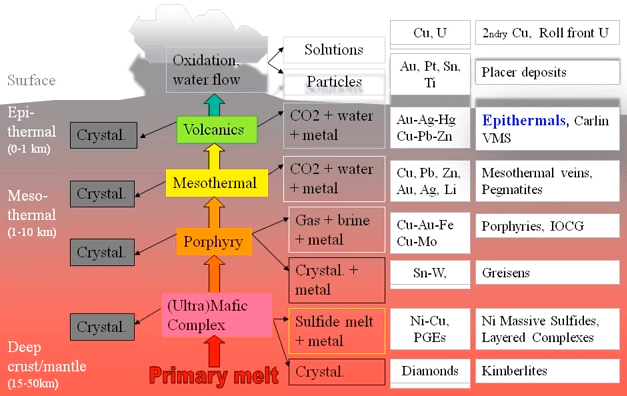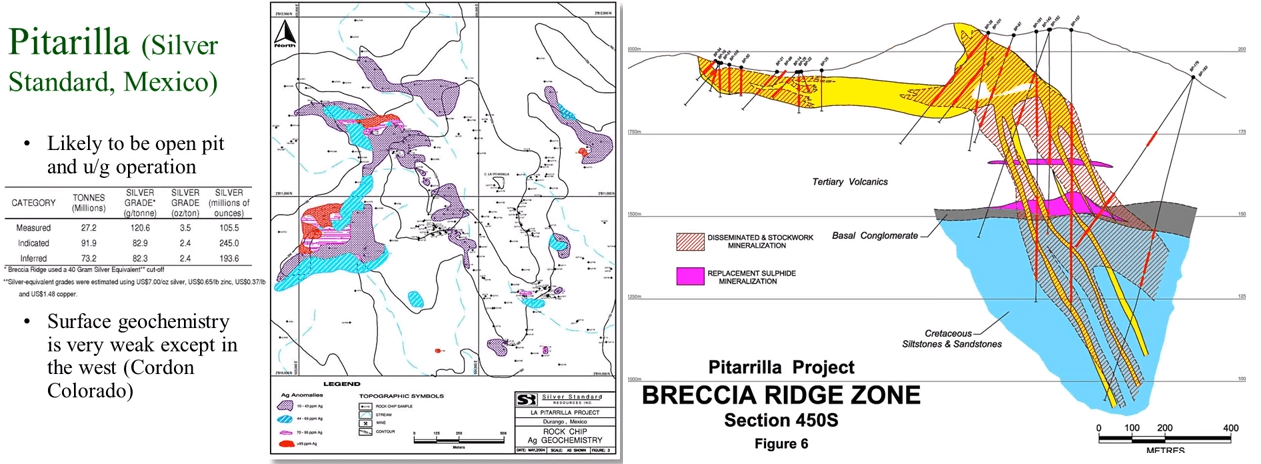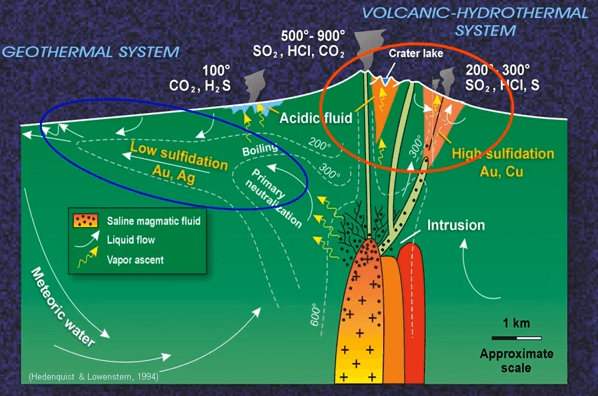
A fascinating group and characteristic of Epithermal gold deposits is that you can virtually see them forming today, simply by visiting hot springs. Like those with Yellowstone in Wyoming or Rotorua in New Zealand. This photo is Pamukkale, low sulfidation hot springs in Turkey, with a beautiful white centre terraces. If you like hot springs, you’ll love epithermal.

Let’s start where we always do in this geology course, by showing how epithermal fit into the overall scheme of things. We remember that nature concentrates the metals by a process of partially melting across the rocks at depths letting the melt rise through the crust and cool, dumping the valueless minerals such as feldspars on the way and concentrating the useful metals in the remaining magma or hydrothermal fluid. Cool, dump the dull stuff and skim off the useful metal.
The word epithermal comes from the Greek words for “nearby heat” referring to the fact that epithermal deposits form very close to the surface of the crust, by definition, within a thousand meters. Temperatures at these depths are generally somewhere between 100 -300 degrees Celsius and pressures are much lower and deeper down so the fluids are sometimes able to boil. There are several types of deposits that form in this environment including Carlin gold deposits, but here we focus entirely on the precious metal, epithermal deposits. These deposits need the best and most reliable gold mining equipment.
Here I describe the close association of epithermal deposits with nearby porphyry deposits, where we find them globally and show why epithermal deposits are economically worth paying attention to. The bulk of the course will cover different types of epithermal deposits, how each of them are formed and I’ll finish up as usual with a short section, on how we explore for these deposits.
To understand epithermal we really need to recap stuff we talked about in the third of the ore geology course which covered porphyry deposits.
In Porphyry deposits the metals then drop out a solution as the escaping fluids cool. Eventually those fluids reach the surface as hot springs. In this course we are interested in what happens to those fluids and how they drop their load of the metals to form epithermal deposits between escaping from the porphyry and reaching the surface. Epithermal so both genetically and spatially associated with porphyries.

This a section through the far southeast and Lepanto deposits in the Philippines where the association was first conclusively proven. Here geological detective work, using isotopic studies and dating show that the fluids from the far southeast porphyries escape upwards and laterally to deposit copper and gold along their escape route forming the Lepanto epithermal deposit.
And here is a spectacular exposure of a porphyry and epithermal pair in Southern Java. The porphyry intrusion outcrops as a small, steep island on the right of the image and a genetically related high sulfidation epithermal deposit curves on the mainland on the left of the image. Note that both here and in the previous case of Lepanto the epithermal are not directly above the porphyry but lay lateral to it following the path that on flowing fluids.
 We will come back to how epithermals form in a minute, but let me first talk about their timing in a global context. Although porphyries are presumably epithermals, they are formed from the Archean until today, vast majority of preserved epithermals are relatively young, tertiary or later i.e. Less than fifty million years. Again this sounds like a long time ago but if we could press Earth’s history into a single year the tertiary would occupy just the last three days of December.
We will come back to how epithermals form in a minute, but let me first talk about their timing in a global context. Although porphyries are presumably epithermals, they are formed from the Archean until today, vast majority of preserved epithermals are relatively young, tertiary or later i.e. Less than fifty million years. Again this sounds like a long time ago but if we could press Earth’s history into a single year the tertiary would occupy just the last three days of December.
Why this discrepancy between the ages of porphyries and epithermals: It’s all a question of preservation. Epithermals usually form in mountain chains and at shallow depths, so they easily and quickly eroded and so there are a few old ones remaining in the geological record.
Where do we find epithermal deposits?
Well they are generally in the same place that porphyries form, in other words above subduction zones and we can narrow down this a little bit more, to subduction zones that have been active in the last 50 million years, this means we’re looking at the so-called Ring of fire around the Pacific Ocean or the Alpine Himalayan plate boundary.
Here’s a map showing the location of significant high and low sulfidation epithermal deposits. You can see that close correlation with active subduction zones, only a few of the deposits associated with older subduction zones such as the appellations, have escaped erosion. You may also note the group with low sulfidation epithermal Patagonia these include ones like Goldcorp’s Cerro Negro, these are near the ring of fire but they’re not actually associated with it, instead they’re due to a metal hot spot that developed when South America and Africa were torn apart during the opening of the south Atlantic about 150 million years ago. These older deposits has survived erosion because they’re formed in low-lying area that was not subject to high erosion rates and they’re also further protected by layers of overlying volcanism.
Why are epithermal deposits important?
Well they are a major source of gold, providing about 12% of the world’s annual gold production, in fact they are the second largest producers of gold globally after the Witwatersrand deposits. Now, I’ve used the term and phrases “high sulfidation” and “low sulfidation” and “intermediate sulfidation” in connection with epithermal and it’s time that I explained the subdivision, because they’re very different beasts and you need to understand their characteristics if you come across them in a press release. If you understand their geological characteristics, it will help you put the exploration results into context.
So what are the differences between “low sulfidation” “intermediate sulfidation” and “high sulfidation” epithermals well the differing sulfidation state of the fluids associated with these deposits, results in a very different detailed mineralogy that form the basis of the definitions. But you probably need access to an old microscope or x-ray diffraction laboratory to identify many of these minerals and most times investors don’t have these, so I’m going to not spend any more time on this aspect, instead I’m going to try and make it simple by talking about where and how they form.
Here’s a very simplified cartoon showing the two end members of the spectrum. Obviously, reality is typically more complex, but this works fine as a first stage approximation. Fundamental difference between High Sulphidation Epithermal Deposits and low sulfidation deposits is the amount and degree of interaction between the magmatic fluid, groundwater and host rocks.
So much for the low sulfidation epithermals. Now let’s quickly cover the last of the broad groups, the intermediate sulfidation epithermal.
Intermediate Sulfidation Epithermal
As the name suggestions they from part way between the high sulfidation and the low sulfidation environments, with a degree of dilution by groundwater but not as the same extent as in low sulfidation systems.  They generally form veins and ridges like low sulfidation epithermals but have coarser banding. However they also contain alunites, like high sulfidation epithermals. In addition to gold they usually contain significant silver, an increasing amounts of lead in the form of galena and zinc in the form of sphalerite as you go deeper.
They generally form veins and ridges like low sulfidation epithermals but have coarser banding. However they also contain alunites, like high sulfidation epithermals. In addition to gold they usually contain significant silver, an increasing amounts of lead in the form of galena and zinc in the form of sphalerite as you go deeper.  The gold and silver deposition is controlled by boiling, base metal deposition is mainly by fluid mixing and cooling because the base metal travels with chloride complexes not thyro-complexes. Examples of intermediate sulfidation deposits include:
The gold and silver deposition is controlled by boiling, base metal deposition is mainly by fluid mixing and cooling because the base metal travels with chloride complexes not thyro-complexes. Examples of intermediate sulfidation deposits include:
- MAG silver, Junaicipio deposits in Mexico
- Kinross- Fruta del Norte deposits in Ecuador
- La Pitarilla in Mexico

At Juanicipio the veins barely reach the surface forming just a wispy seditious zones as you can see in this photo, but at some 400 meters below the surface the boiling zone is encountered and the vein balloons up to 10 meters wide. The well banded and richly mineralized quartz vein filling boiling zone has a vertical extent of 450 meters.  The Standard Pitarilla deposit is in Mexico, it was discovered by an excellent exploration team who looked beyond a low grade and spotted in their chemistry results from sampling surface outcrops understanding that these deposits are vertically variable and that they were looking at the barren cap over a large barely eroded hydrothermal system. Drilling has proven this to be the case and this section shows how the system balloons out of depth.
The Standard Pitarilla deposit is in Mexico, it was discovered by an excellent exploration team who looked beyond a low grade and spotted in their chemistry results from sampling surface outcrops understanding that these deposits are vertically variable and that they were looking at the barren cap over a large barely eroded hydrothermal system. Drilling has proven this to be the case and this section shows how the system balloons out of depth.
Most of the gold and silver mineralization is controlled by a shallow boiling zone, but the system becomes more basic metal rich at depth with lenses of massive bases metals sulphides develop 400 meters below surface.  The Fruta del Norte deposit in Ecuador was discovered by the junior explorer Arillia. The mineralization does not outcrop and was found by drilling bellow a small outcrop of on mineralized centre hidden in the thick tropical vegetation. In this 3D model of the mineralization, you can see steeply dipping structures in the pink with the multi-coloured prisms of mineralization in a vertically constrained boiling zone. The ore is well banded with plenty of sphalerite and galena. Fruta del Norte has reserves of 6.8 million ounces of gold and 9 million more ounces of silver at a grade of just about 8 grams per tonne gold equivalent; and a further 4 million ounces of gold and 8 million ounces of silver in resources.
The Fruta del Norte deposit in Ecuador was discovered by the junior explorer Arillia. The mineralization does not outcrop and was found by drilling bellow a small outcrop of on mineralized centre hidden in the thick tropical vegetation. In this 3D model of the mineralization, you can see steeply dipping structures in the pink with the multi-coloured prisms of mineralization in a vertically constrained boiling zone. The ore is well banded with plenty of sphalerite and galena. Fruta del Norte has reserves of 6.8 million ounces of gold and 9 million more ounces of silver at a grade of just about 8 grams per tonne gold equivalent; and a further 4 million ounces of gold and 8 million ounces of silver in resources.
Lets understand how we explore for epithermal deposits.

